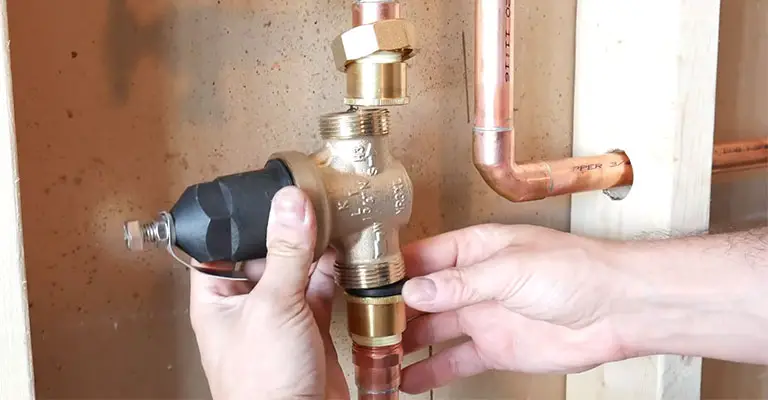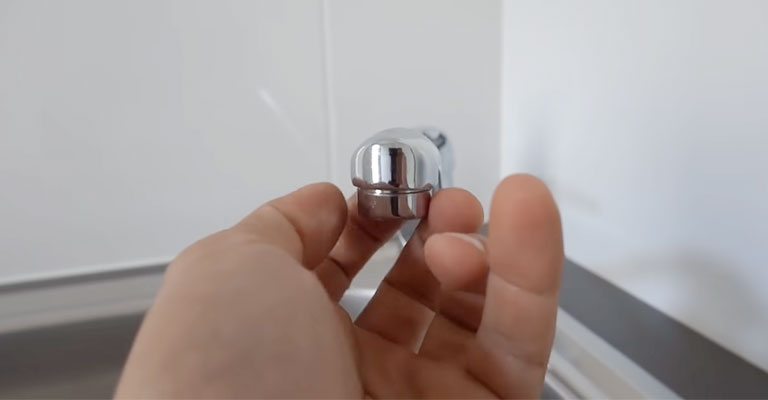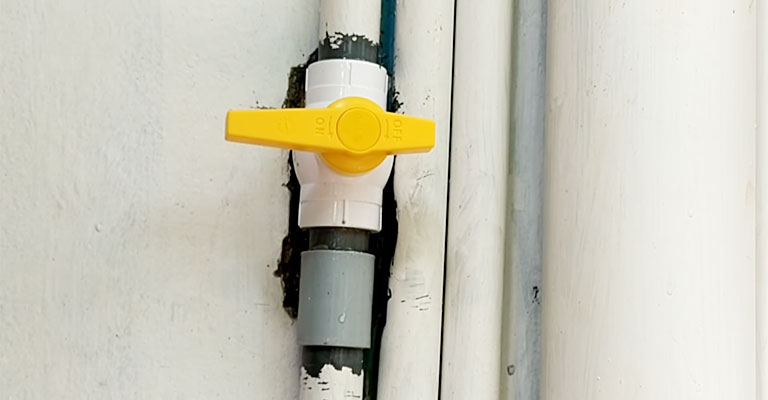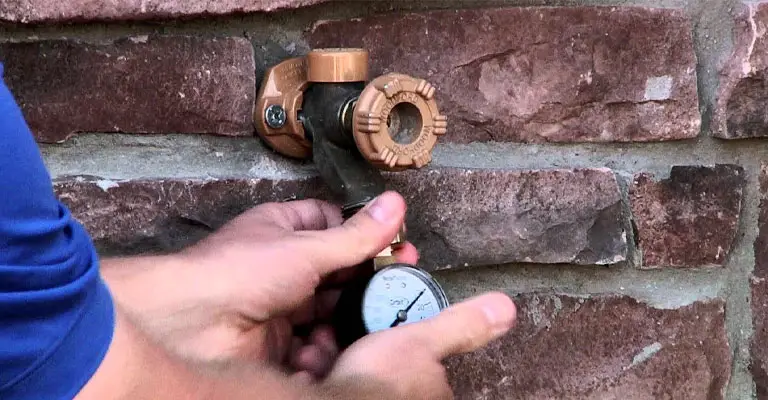Is there a reason why water pressure is slow when other faucets are on, such as when the shower is running, or the kitchen and bathroom faucets don’t work at all? Is the pressure low on several faucets?
It means the initial flow and pressure are insufficient to dispense full flow to all faucets. Recently, did you have any plumbing work done? You likely hired the wrong plumber if you only notice pressure problems after a renovation.
They can mess up your plumbing system by adding too many elbows, bad joints, or supply lines to the wrong size piping. There will come a time when you have to scrap everything and make replacements with the right guy this time.
You may have a problem with the pressure-reducing valve (PRV) or main water shut-off valve if that’s not the case. A PRV is commonly used in municipal water systems that have a water pressure higher than 80 psi.
Using Two Faucets Results In Low Water Pressure?
Get to the bottom of your plumbing problems with this troubleshooting guide if you are experiencing low water pressure in your faucets.
Valves That Reduce Pressure

Low water pressure could be caused by problems with the pressure-reducing valve. There could be a problem with the PRV valve if the water pressure starts normal, then drops.
The most common location for these devices is in municipal systems or situations where the water pressure exceeds 80 psi.
If there is high water pressure, pipes and fixtures may be damaged. You can adjust the PRV to see if it affects your home’s water pressure or if it’s a problem. There is a possibility that the whole unit may need to be replaced if it does not work.
A pressure tank maintains a specific range of pressure when water from a private well is piped to your home.
An ideal water pressure for residential homes is between 45 and 55 pounds per square inch. However, the pressure typically ranges from 45 to 80 psi.
One Tap Lacks Water Pressure

You may just need to clean your faucet if your water pressure is low on one tap only. For example, you may have a corroded aerator or debris in the aerator of your faucet.
Designed to reduce splashing from your tap, the faucet aerator fits inside the cap of your faucet. Water pressure can be severely reduced when it becomes clogged.
The fix is pretty simple, and you could do it yourself. But first, check that the rubber washer has not become dislodged, causing a damming effect once you remove the cap from the tap.
The aerator should also be rinsed and cleaned. A small pin may be needed to clear out tiny holes in the unit if caked-in gunk is present.
Valve Balls at Cheap Prices

A poorly designed system can have a cheap ball valve after the stopcock in the system. It is common for these valves not to be full-bore.
However, even if the pipework around the system is a decent bore, this valve acts as a flow restrictor, even when it is open.
Water cannot get through and is limited. There’s no problem with one service running, but the pressure drops when you have more than one.
It is easy to fix this issue by replacing the cheap part with a marginally more expensive full-bore ball valve.
Why Does Water Pressure Drop When Multiple Faucets Are Running? – Causes And Solutions
There are two issues you may encounter if you have older fixtures. There are a few possibilities here. First, your shower head doesn’t have flow control, so all it does is pump water out.
There are two problems with older valves. First, it is important to note that they mix poorly, so any fluctuation is magnified when it reaches the valve.
Filters are often blocked up, which causes water to flow slowly. The next time you have a problem with your water pressure, do your detective cap and find out what’s causing it.
Based on this information, you can determine the best way to restore things to normal. The answer to this question is based on the assumption that you get city water.
Out Of All Taps

Identifying the cause of your low water pressure should be your first step. Next, make sure all your faucets are working. They all have trouble providing enough pressure, don’t they?
When the cold-water faucets run, does the hot water faucet drip? Do you only lose pressure when several water sources run simultaneously, such as when you flush the toilet while the shower is running?
Your pressure problems can be solved by identifying these clues. After determining the source of your water pressure issue, there are several ways to restore it.
Don’t Forget To Check The Lines
In the United States, 3/4″ is the standard for water lines, so if yours is 3/4″, you shouldn’t have a problem losing water pressure.
You should also ensure that the 3/4″ water line is not feeding your water heater. This is because the water heater sucks out everything when it needs water.
Your central line’s material needs to be checked
In the case of steel, you might be dealing with rusting/shrinkage problems. As well as having health side effects, this should also be replaced.
Perform A Pressure Test

It has been my experience that the water company comes out to my house more than once to check my copper pipe and 3/4″ or greater. Next, a pressure test needs to be performed.
Although they do have access to a gauge, they often place their thumbs over the first opening in the line to check.
A pressure issue occurs if the thumb holds down the pressure (water will come out, but the thumb will not flip back). Homeowners can perform this task in a few minutes.
I know it isn’t an exact science, but I think it is something they can do on their own. See if there is anything before the shut-off before figuring out where the water is coming from.
Outside hose taps can be found at this location on almost all houses. You can use that to test. You might find it in the laundry room of some homes. The thumb test should be done either way.
Make A Call To The Water Company
Call the water company if there is insufficient water pressure through your first outlet in step 4. A technician will check your connection to the main and the pressure coming out. They are responsible if there are problems with the pressure.
Areas Of Low Pressure
If the water pressure was good when we first connected, what would you check next? Of course, an audit should be your first step.
You must have 3/4″ or greater coming into the fixture. Make sure no fixtures are feeding 3/4″. Having a problem with pressure is a result of doing that. Are there any low-pressure areas? The pressure may be restricted by a valve if there is one.
If the issue occurs when you use particular zones in the plumbing or when the issue occurs house-wide, you need to figure out what is causing it.
Generally, valve blockages arise more often than elbow blockages (although it doesn’t happen as much with pex or copper).
Air Trapped
Your home’s water pressure can fluctuate when air is trapped in pipes. This valve causes sputtering and occasional bursts of water flow from your faucet as the water moves through the pipes.
Various factors can cause air to enter pipes, including damaged tank bladders, failing pumps, leaking suction lines, leaks in pipelines, and gas buildup in wells.
What To Expect
The last thing I want to discuss is what you expect. With a 3/4″ line, what do you think you can run? It would be impossible to get enough water pressure if you had three showers on a 1/2″ pipe with shower valves/heads that allow the full water flow rate.
Feeding more than two 5/8 lines slightly with one full-functioning 3/4″ pipe is possible. Although this is true in theory, shower heads will have flow (low) controls, and valves will slow down the water process.
An Issue With The Water Line
Water lines that have been broken or pinched may also be responsible. Your home is typically affected by broken or pinched water lines that are not isolated to two faucets.
A Corroded Plumbing System
Corrosion of the plumbing in homes can lead to various problems over time. If corrosion is severe enough, water pressure drops, leaks, and other issues can occur.
It is a huge undertaking and will be expensive to replace all of your home’s plumbing, but it is worth it in the long run.
Since most piping spans between 20 and 100 years, older homes tend to have corrosion in the plumbing. Copper, brass, and iron materials may last up to 100 years, compared to galvanized steel pipes that last between 20 and 50 years.
If your plumbing is corroded, you may experience low water pressure in your home’s interior and at your outdoor faucets. In addition, the fixtures on garden hoses, outdoor faucets, and similar items may be affected by corroded or leaking pipes.
Is It Possible To Reduce Water Pressure By Using A Mixing Valve?
Water temperature and pressure are controlled separately by a thermostatic mixing valve on some types of shower valves. There is a possibility that a malfunctioning mixing valve could cause reduced water pressure.
Low Water Pressure Can Be Caused By A Bad Faucet
Faulty faucets often cause low water pressure. If the faucet has bad parts, such as a clogged aerator or clogged cartridge, the water pressure will suddenly drop.
There may be a fluctuation in water pressure between two taps in the same room caused by a bad faucet. The first step in troubleshooting low water pressure in two faucets in the same room is to check the faucets themselves.
Finally, How Do You Know If It’s Time For A Replacement?
Your heater may be at fault if you’re having trouble providing steady streams of hot water. Also, your home may have leaks. Look for them.
Water may come from your pipes if you’re sure it’s coming from inside your house. Water flow can be restricted in older homes because galvanized steel pipes corrode from within, causing deposits to accumulate.
Replace the old steel pipes in your home with copper or PEX if you still use galvanized steel. You should hire a professional to handle this, as plumbing is not a job for inexperienced people.






